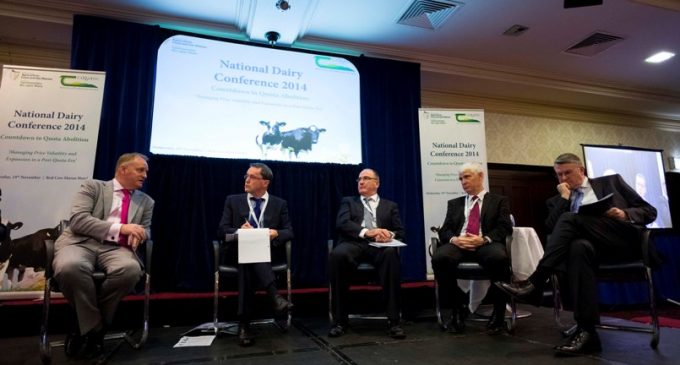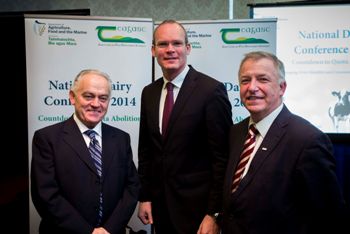Focus on Opportunities and Challenges at International, National and Farm Level in a Post Quota Environment

Irish Minister for Agriculture, Food and the Marine, Simon Coveney TD, hosted the recent National Dairy Conference organised to assess the sector’s preparedness in advance of milk quota abolition in April 2015. The Conference, hosted in conjunction with Teagasc and entitled ‘Countdown to Quota Abolition – Managing Price Volatility and Expansion in a Post-Quota Era’ drew on international and national experience from across the dairy sector to examine issues such as market opportunities, volatility and on farm efficiencies that can drive profitability in the sector.
Participants ranged from across the sector and included CEOs from some of Ireland’s biggest dairy companies and cooperatives as well as farmers and farm groups, banks and other sector stakeholders. Fonterra and FrieslandCampina, two of the five largest dairy producers in the world, as well as the EU Commission, were also represented in proceedings.
Minister Coveney commented: “We are on the cusp of the most fundamental change to Irish Agriculture in a generation. Since 1984, the industry has operated within a quota environment. The shackles come off next April and following that we will have an exciting mix of opportunity and challenge for all stakeholders; farmers and rural Ireland, processors and manufacturers, agri-business and exporters. It is timely that we take stock of where we stand in terms of our preparedness for this new era.”
Bord Bia Chief Executive Aidan Cotter, who opened Session One Market Opportunities for Irish Dairy to 2025, explained how an increasing population will continue to drive global demand for food, and in particular dairy: “The growth in the global demand for food, combined with shifting dietary habits towards more protein based foods and dairy products, is relentless. It is driven by a population growing at 75 million people a year and double that number joining the middle classes”. He added “This means that over the next ten years a market three times the size of the EU, in buying power terms, is being created, principally in Asia but also Africa, now home to more than three quarters of the world’s population. With 40% of its exports already destined for international markets, principally to these regions, as our dairy industry expands it is well positioned to benefit from the sustained growth in demand for dairy products.”

Tom Moran, Secretary General of DAFM, with Simon Coveney TD, Minister for Agriculture, Food & the Marine, and Gerry Boyle, Director of Teagasc, at the National Dairy Conference 2014.
Kevin Bellamy, Senior global dairy analyst with Rabobank International, who addressed the conference on Managing Volatility in a Post-Quota World, said: “With production growth in Ireland dependant on global export markets price volatility will continue to impact Irish businesses, especially farmers whose small businesses are least equipped to cope. While governments might protect against market crises, and price risk management tools are emerging, Irish supply chains need to develop effective strategies to manage volatility if they are to grow and prosper.”
Director of Teagasc, Professor, Gerry Boyle explained: “The most recent expansion survey from Teagasc indicates that about 60% of dairy farmers are planning to expand production in the two years following the abolition of quotas. A small number of drystock and tillage farmers – 1.5%, or less than 1000 farmers – are likely to convert to dairy and a smaller number again are likely to re-enter milk production. These plans imply a growth in milk production up to 2017 of about 18%. This level of planned expansion is in line with Food Harvest 2020 targets. Ireland’s unique grass-based milk production model is ideal for the post quota environment. It’s competitive, profitable, resilient and sustainable. But there’s room for improvement. The top 1/3 of dairy farms earned a profit of nearly €2,500 per hectare last year. This is about 4 times that achieved by the bottom 1/3. Moreover top-ranging dairy farms saw their net margin growing by about €33/ha over the last 10 years, despite a severe price-cost squeeze. These farmers achieved these results through innovation on their farms.”
CAPTION – top picture:
Pictured at the recent major dairy conference entitled ‘Countdown to Quota Abolition – Managing Price Volatility and Expansion in a Post-Quota Era’ were (left to right): Kevin Lane CEO, IDB; George Lee, Moderator; Michael Hanley, CEO, Lakeland Dairies; Donal Dennehy, Operation Director of Danone Ireland; Jim Bergin, CEO, Glanbia Ingredients Ireland Ltd (GIIL).


































